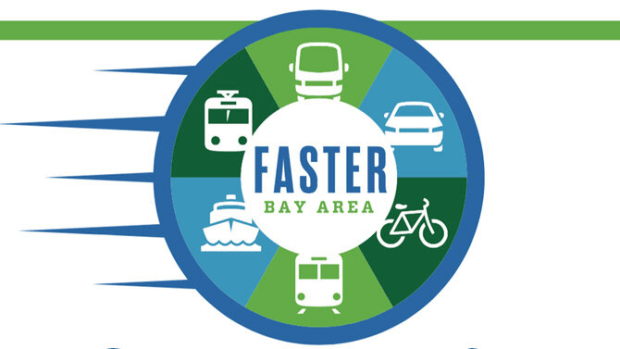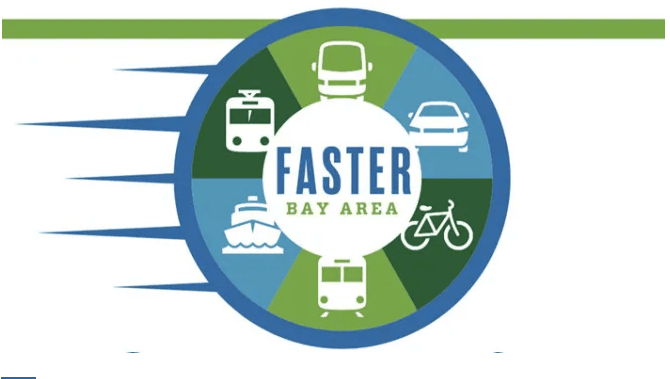
Note: GJEL Accident Attorneys regularly sponsors coverage on Streetsblog San Francisco and Streetsblog California. Unless noted in the story, GJEL Accident Attorneys is not consulted for the content or editorial direction of the sponsored content.
After months of laying the groundwork, the coalition behind the proposed “Faster Bay Area” (FASTER) ballot measure decided in March to postpone their efforts in light of the uncertainty caused by COVID-19.
As FASTER regroups for 2021 or 2022, Streetsblog decided to reach out to experts who bring different lenses to ballot measures, a mix of local advocates, national analysts, and veterans of ballot measure campaigns from other parts of the country, for their thoughts. Our first interview was with Steven Higashide, the Director of Research at Transit Center and author of Better Buses, Better Cities: How to Plan, Run, and Win the Fight for Effective Transit.
For our second interview, we spoke with Jeffrey Buchanan, the director of public policy for Working Partnerships USA.
Today, we speak with Angie Schmitt, a past editor with Streetsblog USA and author of the upcoming book, “Right of Way: Race, Class, and the Silent Epidemic of Pedestrian Deaths in America”
Damien Newton (SBSF) – Thanks for being with us today and congratulations on the book! I look forward to reading it.
Now, in our pre-interview, you told me a story about someone recording how people walked on the street in his hometown and how it showed how people react when basic transportation infrastructure is missing. Can you retell us that story?
Angie: Sure. And thanks for having me.
This is somewhat of a different environment, it was actually in Rockford Illinois. What the camera found was that when someone is uncomfortable with the environment, like if there is a bus shelter missing or if there’s a curb cut missing then they’ll behave in a way that makes sense, but isn’t what is expected.
For example, if it’s raining, then they might cross the street to wait under an awning. Then when the bus is coming, they race across the street. In the rain.
I assume the Bay Area has better…
SBSF: You’d be surprised.
Angie: Ha.
Well, another takeaway from the book is how much change we’ve seen in the suburbs. If you look at a map of racial change in places like Atlanta and Detroit…If you look at their suburbs in the 1990’s, you have really dramatic segregation. That’s really changed dramatically in the last two decades.
The northern suburbs were founded by segregationists, literally. Many of these communities were founded and led by these people. But now there’s been a shift, and the infrastructure hasn’t kept up with it.
There’s a lot more lower income people. There’s been a suburbanization of poverty. Living in areas that aren’t suited to transit and aren’t suited to walking. That’s putting people in danger.
Now in Los Angeles and the Bay Area, there’s been a lot of gentrification and this problem needs to be addressed (in transit planning and funding).
SBSF: When we talk about these issues in terms of ballot measures, so much of the conversation is about e-buses, transit lanes, BRT, rail lines…the big shiny things. But if I’m hearing you correctly, we need to be concerned about not just what planners like to call the First Mile/Last Mile problem, but also the overall experience of riding transit. And that doesn’t start when someone steps onto a vehicle, it starts when they leave their house, office, or wherever the trip is starting from.
Angie: Yes. If the waiting environments are undignified, which they are in a lot of places, then people aren’t going to want to do it. Nobody wants to stand outside, with the sun beating down on them or the rain pouring down on them and wait for a bus.
SBSF: You were talking earlier about people waiting at the closest awning, sometimes across the street, when its raining and there’s no shelter. I was wondering if there’s ever been a ballot measure that focused, not just in the text but in the campaign, around building better bus stops and making the waiting experience a better one. It’s not just a comfort issue, it’s a safety one.
Angie: San Antonio has made big investments in their bus stop infrastructure. Also, Boston made an effort a few years ago.
We used to do the “sorriest bus stop” tournament at Streetsblog…
SBSF: …oh, I remember…
Angie: …to try and shame agencies and cities into doing a better job. But one of the agencies in Boston did a survey to analyze all their bus stops and how many benches there were and what conditions were, to do a systemic intervention.
So they deserve some credit.
And in San Antonio they invested a lot into building sturdier shelters. And in a place that’s so hot, so sunny, that’s really needed.
SBSF: Down in L.A., Sahra Sulaiman did a story back in 2012 called “Desperately Seeking Shade” that was about just that issue. In the article, you can see picture after picture of people basically trying to cram their bodies into these slim slivers of shade provided by sign polls or electric polls. A couple of ballot measures later, and very little has been done.
Angie: 99% Invisible did an episode on that, I wonder if they were inspired by her work. Sahra was way ahead of the curve on that one, as usual.
SBSF: So we’re talking a lot about the experiences of people using transit, and how a bad experience will discourage people and even drive off those that aren’t transit dependent. But when we’re talking about building a ballot measure, how important is it to set aside money to improve those conditions, be they bus stops or headway times or other service issues, versus building the large headline-grabbing projects? I’m not looking for specifics, but generically speaking…
Angie: That’s not a question you can really answer generically though.
Operations has been underloved, underemphasized and underfunded a lot of times. Frequency is very important to the service. There are even people that will say that the waiting experience doesn’t matter if the service is reliable.
It’s hard to say generally because different cities are different. Operations has been underfunded in these measures compared to the splashy projects. Just look at L.A., which has had a lot of new projects in recent years, but overall ridership hasn’t increased.
SBSF: From a sales standpoint, we almost never hear a measure sold as improving the lives of the people that ride it. Using the LA example it’s “we’re going to build a train to the sea!” and not “we have one of the biggest bus systems in the country, we’re going to make it better for the people who use it!”
And I get why they do it, but it’s always frustrating to see it rolled out that way. It seems the existing riders, especially the transit dependent riders, are taken for granted.
I should add as a sort of disclaimer, we’re recording this on July 29th. The San Francisco Board of Supervisors approved their weird Caltrain measure for the fall ballot just last night, and the fact that the political gamesmanship proved more important than the lives of the existing riders is on my mind.
Anyway, you covered probably dozens of these kinds of measures in your time with Streetsblog USA. Looking at those measures, what would you think of as best practices to get one of these measures to the finish line?
Angie: One of the memorable failures is a measure from Nashville. It’s one that had a lot of controversy, ginned up by groups such as the Koch brothers.
But sometimes groups emerge locally and they are loud, and they can be a much bigger threat.
In Nashville, it was a group of car dealerships. They were very threatened that a local sales tax would encourage people to just go over the county line to buy a car because they would save so much money buying the car.
This is going to sound unorthodox, but these critics can essentially derail a project. So I think it’s important to see who can be harmed, legitimately harmed, and identify them and try to mitigate that harm. As advocates, we sometimes tend to say “your business will be fine.” But a family owned car repair shop or dealership really can be harmed. If we’re talking about projects, there are some businesses that really might go under.
So you should include some money in these project budgets to help get these businesses through. Now look, there was a lot of dark money in Nashville’s elections and I’m not saying we should spend money to try and fix every complaint.
And Nashville is a different political climate in California. But listening to the local critics, and people that have the most to lose, and trying to soften the blow to them can really help. I think it’s worth trying to ease the concerns for those people.
SBSF: In California, it seems that whether or not a ballot measure passes depends in large part on how well organized and how well funded the opposition is. In California there’s a well-funded group that fights every major ballot measure, and sometimes they win. They definitely would be in the fight for a mega-measure like Faster Bay Area.
But how much local opposition there is and how well organized they are is often the difference between a winning and losing measure. And it doesn’t have to be a bunch of rich people, just people with a compelling message that they can get in the newspapers, get on talk radio and just get out there.
Angie: I think you need to try and distinguish between good faith critiques and bad faith. If you have the Koch brothers say something really off the wall, you may need to counter it but you should not try and work with them.
But if you have a small business, or a group of small businesses, and they are worried about how that business is going to survive, or if you have a community that has a gentrification concern… These are concerns that need to be taken seriously.
In Nashville, they didn’t see those kind of concerns for what they are. They probably didn’t have the support they thought they did in the first place, but then they made some big mistakes.
SBSF: Steve Highahside actually talked about this in our first interview, and not generically but specifically about Nashville: how they didn’t have the support they thought they did, how they didn’t bring together a broad coalition until after the measure was put together, how they banked too much on the popularity of the mayor…
Angie: Even so I was surprised by the results (in Nashville), but maybe it was also kind of a fluke. They had a big scandal with their spokesperson, which honestly might have been over-hyped, but in that case there was a perfect storm of bad things that happened.
But these measures are so very important right now. COVID has been a disaster for transit across the whole country. We hope the feds are going to step up, if not now then hopefully with a new administration next year. So we’re probably going to have to step up to support these essential services.
If we want to talk about equity and racial justice for our cities, we can’t lose our transit agencies. We can do better than that.






